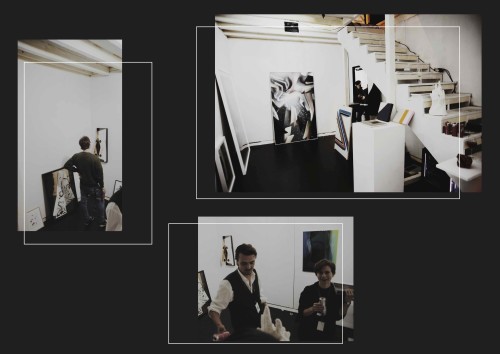
Frank Balve – Anhöhe, 2017, wood, metal, fabric, 700 x 700 x 400 cm




 Frank Balve – Anhöhe
Frank Balve – Anhöhe
In Berlin, at the end of the Kieler Strasse, there is a watchtower of the former border area, which is now used as a memorial. This is where the Kieler Eck management office once stood. It is one of the only three preserved of the 302 watchtowers, which were used for German-German border security. Frank Balve draws a parallel to this urban element of the capital with his new work Anhöhe. It is an installation that presents the program of the MaxWeberSixFriedrich gallery at the “Positions” art fair in Berlin.
The word Anhöhe (hill) is according to the Duden “a moderately high elevation in the terrain”; a hill, something that occurs in nature. The title stems from a text that Balve wrote in 2012 and which is printed on banners on the facade. Text transforms in an idea which becomes a thought complex which becomes art; something that often happens with the works of the Munich-based artist. The term Anhöhe in itself arouses very different associations than the massive construct – it measures 7 meters in height and width and 4 meters in depth – which stands before us at the fair: not only wrapped in the deep-black fabric and Nato-barbed wire at its crown. It develops a truly martial appearance, complemented by persons as staffage figures, whose association to the tower can be seen through their black clothes. They surround the tower, guard it, and accompany it, change it and are its extension. The artist correctly plays with the fears and inhibitions of the visitor: Is it really possible to approach and enter? The gloomy tones as well as the disturbing effect are typical characteristics of Balves works, described by Dr. Susanne Ott in her biography of the artist, which are clearly visible here.
You may be reminded of the Tower (1987-89) by Erwin Heerich which, as a “walkable sculpture”, focuses on the relationship between sculpture and architecture.
Unlike Balve’s earlier works, which began in the class of ceramics and glass painting from Norbert Prangenberg at the Munich Academy of Fine Arts in 2009, the viewer is not condemned to remain outside and peer inside through a glass pane or fence. Here, art itself becomes a place of art, for it is an exhibition space that is accessible and experienceable.
On the ground floor of the tower you can find the contemporary program of the MaxWeberSixFriedrich gallery, on the floor above you can find works from Joseph Beuys, John Chamberlain, Wilhelm Mundt and Frank Balve.The inner spaces are greatly reduced to emphasize the art presentation; white embolden the space created by Balve in the consciousness of the visitor, since the visitor’s attention is drawn to the works and not to the architecture. Thus, a kind of stage is provided, which reminds of a well-protected chamber for art and wonders.
Anhöhe is, as the name already suggests, widely visible in the exhibition hall, and also regularly attracts the attention of visitors with the mist horn built into it. It attracts and deters at the same time. Defense tower, memorial, treasury, or even spiritual rest room?
These may be all concepts suitable for Anhöhe and at the same time not. But the work of Frank Balve must and cannot be categorized. It is a development from older works, which have involved innumerable new ideas, which cannot be described with simple categorizing.
Professional Preview : Thursday, 14 Sep 2017 | 2 – 6 pm (by invitation only)
Opening reception : Thursday, 14 Sep 2017 | 6 – 10 pm
Public Days
Friday, 15 Sep | 1 – 8 pm
Saturday, 16 Sep |1 – 8 pm
Sunday, 17 Sep | 11 am – 6 pm
We will feature works by
Frank Balve, Joseph Beuys, John Chamberlain, Saskia Friedrich, Elke Härtel,
Nina Annabelle Märkl, Wilhelm Mundt, Mirko Reisser, Jens Wolf, Joseph Beuys,
Andreas Schulze, Ralf Ziervogel, Peter Zimmermann
